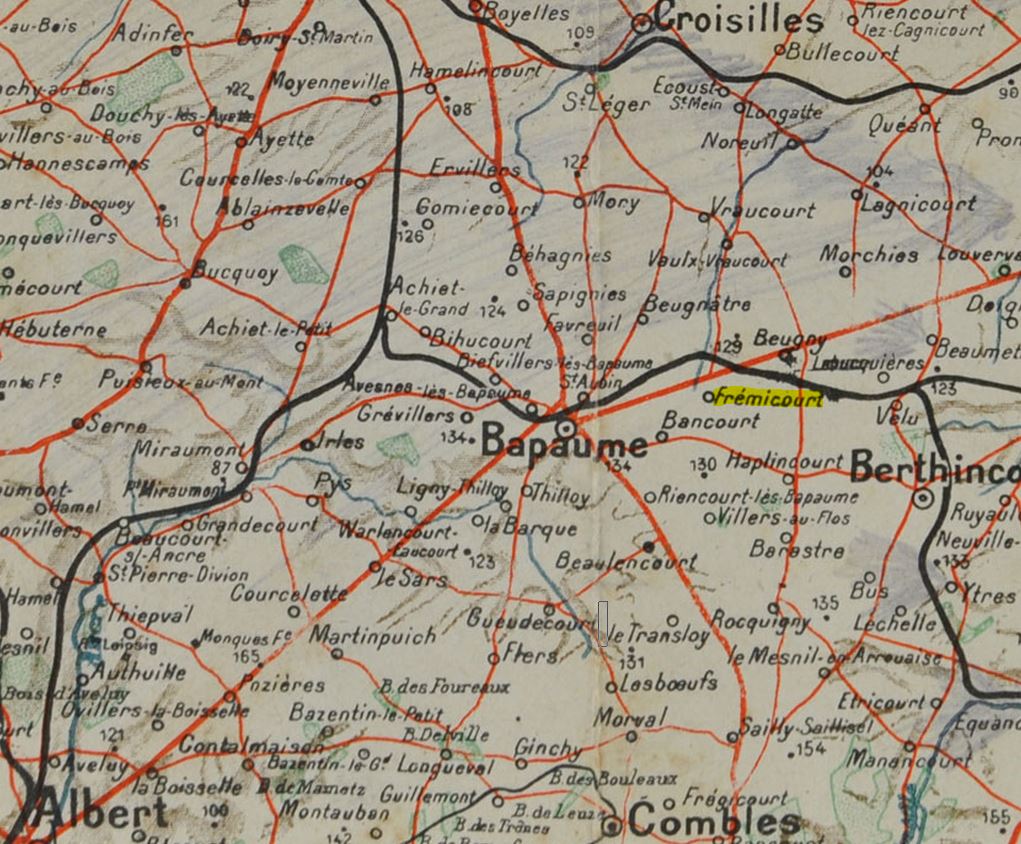Location and pre-war history

Frémicourt can trace some history back to at least the 1300s but never developed beyond being a rural, agricultural, hamlet and even by 1911 had a population of just 382. Before 1914, a standard gauge railway from Albert and Achiet-le-Grand passed the village on its northern side, going eastwards to Hermies, Marcoing and Cambrai.

Great War history
Frémicourt came into the war when German forces under Crown Prince Rupprecht advanced towards Bapaume on 26 September 1914. A subsequent clash with French forces and eventual stabilisation of the front left the village well behind German lines. It became used for billeting and organisation of supply for German forces on the Somme front.

Frémicourt is recaptured after Germans withdraw

Operation Alberich not only included the deep withdrawal to the Hindenburg Line but the systematic destruction by the Germans of the area being given up. This was to hinder the British follow-up, and render the ground as operationally difficult as possible. Vilages were razed, railways and roads blow up, water sources poisoned, buildings, dugouts and trenches booby-trapped.

At 5.10pm on 18 March 1917, I ANZAC Corps reported to Fifth Army that a brigade of 5th Australian Division had advanced through Frémicourt but was now held up by enemy fire from Delsaux Farm (near Beugny).

The village would remain in Briitish occupation until 24 March 1918. As the advance pressed on in the wake of the German withdrawal in March 1917, Frémicourt fell further into the rear and became the location of camps, formation headquarters, medical units, supply dumps and (particularly to the east towards Beugny) surrounded by batteries of heavy artillery. It demanded a huge amount of labour and logistical effort to turn the devastated area habitable and to provide goods lines of communication to the new forward area.



Frémicourt falls to the German 1918 spring offensive “Michael”

Some German progress was made on 22 March, and the 1/4th Battalion of the King’s Shropshire Light Infantry moved up into Frémicourt from Beaulencourt (arriving in the early hours of 23 March).




Frémicourt recaptured for the final time




While occupying the village, the Germans created an extension to the communal cemetery which eventually contained burials of 1,346 of their own soldiers and 136 officers and men from the United Kingdom who fell in March, 1918. It was taken over in September 1918, by British and Dominion units, who used it for clearing the battlefields and for fresh burials, and added 94 graves. All the graves have now been removed to other cemeteries, notably the nearby Bancourt British Cemetery (below).
The sacrifice of Frémicourt was recognised by the award of the Croix de Guerre to the village in 1920.
Frémicourt post-war and today
In the autumn of 1921, Arthur Behrend revisited the area in which is Heavy Artillery Brigade had been in action in March 1918. He added an atmospheric chapter about it, “Reprise” in his famous memoir “As from Kemmel Hill”, and mentioned Frémicourt as his little local train took him from Achiet-le-Grand towards his destination of Beugny.
It was through my ears that I first became aware how times had changed. We had pulled up in the mist. There were some dim buildings, and the guard ran up and down shouting “BeeveeYAY! BeeveeYAY!” Wht was he saying? Trying to tell me that Biefvillers was no longer known as Beef Villas? I was hard to believe, perhaps because I did not wish to believe … None the less it was true.
On again. This mists were lifting. This bit of country looked familiar, and we stopped a second time. “FRAYmeecour! FRAYmeecour”, the guard was shouting now … Frémicourt. But, Fraymeecour or Fraymeecourt, it was the same little hamlet in which the headquarters of 51st and 56th Divisions had lived during our time.
Extract from “As from Kemmel Hill” by Arthur Behrend (London: Eyre & Spottiswood, 1963)

For the battlefield visitor, there is little see in Frémicourt except for the landscape and the village’s war memorial, inaugurated in 1923. It has no facilities, shops or accommodation, with the nearest being in Bapaume, although there is an evening friterie in Beugny.


Bancourt British Cemetery is the nearest to the village and is largely a post-war conentration cemetery that now contains almost 2,500 graves. Not far away are Delsaux Farm and Red Cross Corner Cemeteries at Beugny, and Favreil British Cemetery.
The population of the village is still only around 250-300.
Links
Other places in the Gazetteer of the Western Front
A chaplain in the war: Frémicourtois Camille Vitel (Archives de Pas de Calais)